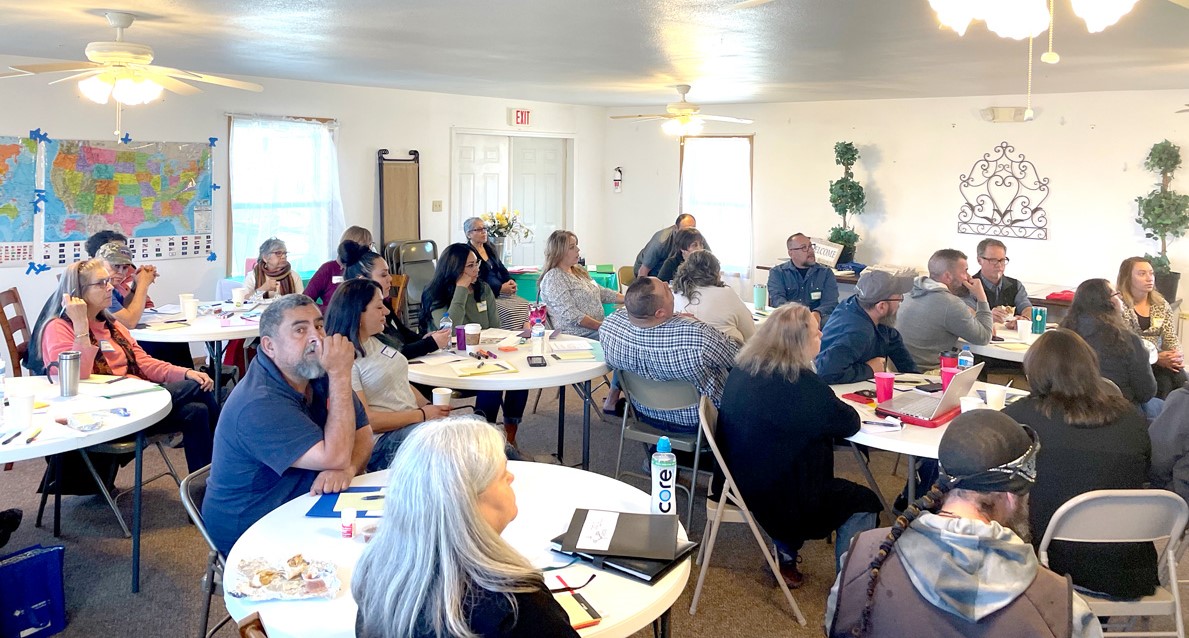On Saturday, April 9, 31 community-concerned citizens of the Questa area attended a day-long workshop on Asset-Based Community Development (ABCD), facilitated by Ruben Medina of The Denver Foundation. The event began with a meet and greet the previous evening. Benita Muñiz, a volunteer for the Questa Del Rio News, was inspired to set up this workshop in Questa, having had previous experience with ABCD and Ruben.
The Denver Foundation (per their website) is “the largest and most experienced community foundation in the Rocky Mountain West. For nearly 100 years, people in Metro Denver and across Colorado have trusted The Denver Foundation to steward charitable funds to meet today’s needs and tomorrow’s opportunities. In partnership with generous donors and community partners, we lead a community-wide effort to build a better future for everyone.”
Saturday’s participants represented a cross-section of individuals from many parts of our community: business, recovery efforts, mothers, veterans, construction workers, non-profit leaders, faith-based participants, school board members and village staff. In their introductions, participants spoke passionately about “improving the motherland,” “creating a community where our kids can thrive right here and not have to leave,” implementing the idea that “it takes a village to raise a child,” and “coming together in unity” rather than despairing or isolating over issues such as alcohol and drugs, hopelessness, division, and differences.
Ruben led the group through various hands-on exercises in groups of two (dyads) to develop relationships and connections and then in small groups to perform “asset-mapping” in the areas of individuals, associations, institutions, physical aspects, the marketplace, and cultural stories of the Questa area.
These existing groups of informal associations in our community included knitting, Bible study, or “women who travel,” and institutions of the community, such as non-profits, school systems, and village governments. Collectively, groups identified 102 associations and institutions, albeit with much overlap. Then he invited small groups to identify specific physical assets, such as unused open spaces or buildings, marketplace exchange (including alternatives, such as time banks, instead of currency exchange and business cooperatives) and cultural stories.
Cultural stories includes integrating traumas of discrimination with transformative stories that strengthen the community. Ruben stressed that asset mapping as an ongoing process is a “means of community affirmation, a guide to relationship building, and creating a different basis for institutions’ sharing power.”
ABCD represents an approach to community development that emphasizes
- the power of citizens through ever expanding relationships;
- identifying and building upon six different kinds of community assets; and
- not allowing “others” (such as institutions, government, outside influences and corporations) “write the narrative” of a community.
First and foremost, Ruben emphasized the foundational building block of relationship-building through knowing individuals in a meaningful way, to identify their gifts and passions. Working again in dyads, the group learned of others’ “gifts of passion, wisdom, creativity, knowledge and life challenges that have created passages to new understanding. All community members at the ABCD table come each with unique gifts.”
Ruben urged participants to “expand circles of passion and influence.” He gave the image of reversing the traditional power model—a CEO or leader on top of a triangle making decisions that “trickle down to constituents.” Instead, citizens who have “skin in the game” come together in large numbers of civic engagement to create change that flows upward towards traditional leaders who then have to say, “yes.” It may seem that Ruben is working against municipal governments, when in fact, he is a city councilor of Aurora, CO, and in using ABCD models, is enacting change from the inside out!
Ruben offered a moving example of ABCD community development from Moorhead, a predominantly African-American neighborhood of Aurora, Colorado. Here the Moorhead Park Recreation Center was built slowly over seven years and became “the hub of the wheel of the community,” growing to host 40,000 visitors per year and employing 50 community members, including marginalized citizens, such as a formerly unhoused man with the unique gift of teaching boxing. He emphasized the importance of problem-solving obstacles that arose, rather than accepting “no’s” or giving the city government “power over community desire.”
As a way forward from all the new learnings through this ABCD workshop, Ruben offered a process that could be facilitated by an organizer with connections inside and outside the community. That process would include
- the coming together of community vision,
- strategies to make it so,
- problem-solving of barriers,
- evaluation, and celebration as it progresses, and
- continuous community member engagement and leadership development. He also offered the possibility of block captains and small community action project development within that larger vision.
Many thanks to those who made this invigorating and hopeful workshop possible: Benita Muñiz, the LOR Foundation, the Taos Community Foundation, and Lynn Skall of Questa Economic Development Fund. A special note of appreciation goes out to Pastors Gayle and Peter Martinez of Living Ministries for hosting the workshop and helping to organize it.



